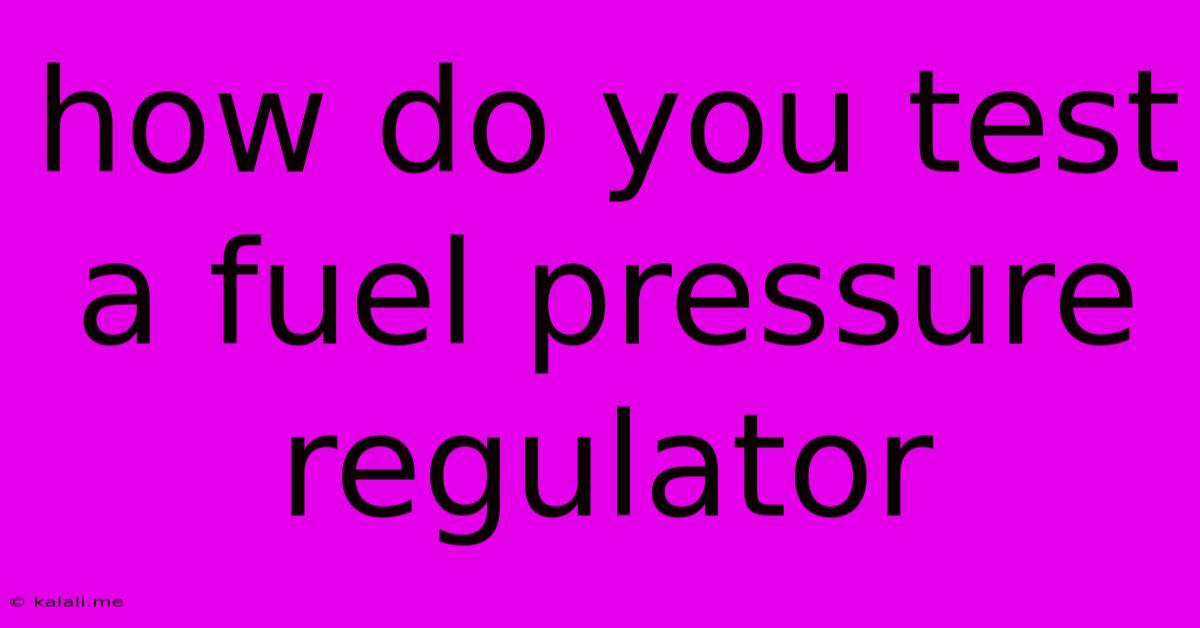How Do You Test A Fuel Pressure Regulator
Kalali
Jun 06, 2025 · 3 min read

Table of Contents
How to Test a Fuel Pressure Regulator: A Comprehensive Guide
A malfunctioning fuel pressure regulator (FPR) can significantly impact your vehicle's performance, leading to poor fuel economy, rough idling, and even engine failure. Therefore, knowing how to test a fuel pressure regulator is a valuable skill for any DIY mechanic. This guide provides a step-by-step process for testing your FPR, helping you diagnose potential issues and save on costly repairs.
Understanding the Fuel Pressure Regulator's Role
Before diving into the testing process, let's briefly understand the FPR's function. The fuel pressure regulator maintains the correct fuel pressure within the fuel rail. It does this by regulating the fuel pressure based on engine demands. If the pressure is too high or too low, engine performance will suffer. Symptoms of a bad FPR often include difficulty starting, stalling, rough running, or a noticeable drop in fuel efficiency.
Tools and Materials You'll Need:
- Fuel Pressure Gauge: This is the most crucial tool. It accurately measures the fuel pressure in your system. Ensure it's compatible with your vehicle's fuel type.
- Fuel Line Disconnect Tool: This helps you safely disconnect fuel lines without causing damage.
- Wrench Set: You may need various wrenches to access the fuel pressure test port.
- Shop Rags: For cleaning up any spilled fuel.
- Safety Glasses: Always protect your eyes when working with fuel.
- Gloves: Protect your hands from fuel and potential contaminants.
- Vehicle Service Manual: Consult your vehicle's manual for specific procedures and pressure specifications.
Testing the Fuel Pressure Regulator: A Step-by-Step Guide
1. Safety First!
- Disconnect the negative battery terminal. This prevents accidental electrical shorts and ensures your safety.
- Work in a well-ventilated area. Gasoline fumes are flammable and harmful.
- Always wear safety glasses and gloves.
2. Locate the Fuel Pressure Test Port:
- This port is usually located on the fuel rail. Your vehicle's service manual will pinpoint its exact location.
3. Connect the Fuel Pressure Gauge:
- Carefully connect the fuel pressure gauge to the test port using the appropriate adapter. Make sure the connection is secure to prevent leaks.
4. Start the Engine and Monitor Pressure:
- Start the engine and allow it to run for a few minutes. Observe the fuel pressure reading on the gauge. The pressure should stabilize at a specific value, which is specified in your vehicle's service manual. This is your base fuel pressure.
5. Vacuum Test (Most Important Step):
- This is the crucial step to diagnose the FPR. With the engine running, carefully apply vacuum to the vacuum port on the fuel pressure regulator. You can use a vacuum pump or even carefully suck on the vacuum line (use caution and avoid ingesting any fumes). The fuel pressure should drop significantly. If the pressure remains largely unchanged, the FPR is likely faulty.
6. Engine Off Pressure Check:
- Turn off the engine. The pressure should hold for a period of time. A rapid drop indicates a leak, potentially in the FPR itself or elsewhere in the system. Consult your manual for the specific hold time specification.
7. Interpreting the Results:
- Pressure significantly lower than specified: This may indicate a faulty fuel pump, clogged fuel filter, or other fuel delivery issues.
- Pressure significantly higher than specified: This could point to a malfunctioning FPR that's not releasing pressure correctly.
- Pressure doesn't hold after engine shut off: Indicates a leak somewhere in the fuel system, potentially the FPR or elsewhere.
- Pressure doesn't drop with vacuum applied: This strongly suggests a faulty fuel pressure regulator.
8. Replacing the Fuel Pressure Regulator (If Necessary):
- If your tests indicate a faulty FPR, replacement is necessary. This process will again require consulting your vehicle's service manual for specific instructions, but generally involves disconnecting the fuel lines, unbolting the regulator, and installing the new part. Remember to follow all safety precautions.
Disclaimer: This article provides general guidance. Always consult your vehicle's service manual for specific procedures and pressure specifications. Improper handling of fuel systems can be dangerous. If you are not comfortable performing this test, consult a qualified mechanic.
Latest Posts
Latest Posts
-
Waiver For Felony To Get A Job
Jun 07, 2025
-
When Do You Start Applying For College In Japan
Jun 07, 2025
-
Why Groups Of Three Students Work Better
Jun 07, 2025
-
Diablo 3 Ring Of Royal Grandeur
Jun 07, 2025
-
How To Send Mass Text On Iphone Without Group Message
Jun 07, 2025
Related Post
Thank you for visiting our website which covers about How Do You Test A Fuel Pressure Regulator . We hope the information provided has been useful to you. Feel free to contact us if you have any questions or need further assistance. See you next time and don't miss to bookmark.